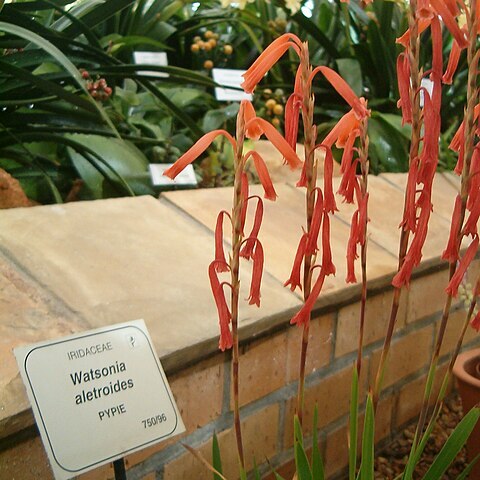Plants 250-600 mm high. Corm subglobose, 20-30 mm diam.; tunics coarsely netted. Stem erect, simple or with 1 or 2 short, ascending branches. Leaves 4 to 6, mostly ± basal with uppermost partly or entirely sheathing stem below, 1/2-2/3 as long as spike, lanceolate to linear, (3-)5-10 mm wide, glossy, midrib and margins lightly to moderately thickened and hyaline; bract-like cauline leaves 1 or more. Spike usually 8-to 20-flowered; bracts usually overlapping, broadly clasping below, green below but dry and pale brown distally with evident netted venation, becoming dry throughout and lacerate, 11-24 mm long, inner ± as long, minutely forked apically. Flowers zygomorphic, reddish or orange, occasionally purple or pink, inner tepals usually paler or whitish; perianth tube with lower part 12-15 mm long, emerging 5-8 mm from bracts, upper part subcylindric and slightly to strongly pendent, 25-28 mm long, 5-8 mm diam. in middle; tepals weakly spreading distally, obovate to oblanceolate, ± 10 x 7-9 mm. Filaments unilateral and declinate, 30-35 mm long, shortly exserted from tube but included in flower; anthers 4-5 mm long, yellow. Style arching below stamens, dividing near base of anthers, branches ± 4 mm long. Capsules fusiform-attenuate, 15-25(-30) x 4-8 mm long, dehiscing only above, rarely aborted and replaced by cormlets. Seeds linear, 6-8 x 1.0-1.5 mm, shortly 2-winged.
More
Perennial herb 0.25–0.7 m high. Corm c. 2.5 cm diam. Basal leaves (15–) 30–60 cm long, 0.5–1 cm wide. Inflorescence spike unbranched with flowers c. 1.5–2.5 cm apart. Bracts 1–2.5 cm long, green below, dry and brownish above. Flowers zygomorphic, patent, red-orange to purple or pink. Perianth tube 3.5–4.5 cm long, curved in basal half, lower part narrowly cylindric (c. 1.5–2 mm diam.) widening rather abruptly into a broader, cylindric upper part (c. 8 mm diam.); lobes elliptic, c. 0.9–1 cm long, 0.5–0.7 cm wide, hardly spreading. Stamens asymmetrically arranged to one side of the flower; anthers c. 5 mm long, yellow; staminodes absent. Style shorter than perianth, branches deeply divided into 2 segments. Capsule fusiform, 1.5–2.5 (–3) cm long. Bulbils absent.
Cormous geophyte to 45 cm. Leaves sword-shaped. Flowers red, sometimes pinkish, nodding on a recurved tube, tepals short, usually barely spreading. Capsules fusiform-attenuate.

